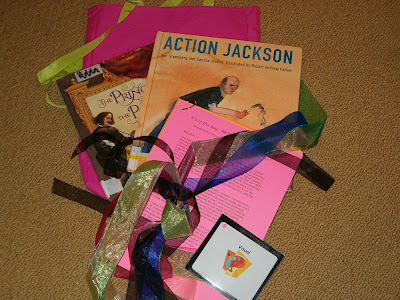
 Action Jackson by Jan Greenberg & Sandra Jordon illustrated by Robert A. Parker
Action Jackson by Jan Greenberg & Sandra Jordon illustrated by Robert A. Parker• A fictionalized account of Jackson Pollock’s process of action painting, where the author describes how Pollock worked to make such paintings as Untitled, 1950 (Lavender Mist).
• Read the book Action Jackson to the class.
• Discuss how different artists use different techniques for creating art. Talk about how the author describes how Jackson Pollock used his materials.
Moving the Action
• In groups of 4-5, choose a variety of scarves, ribbons and yarn. Create a creative movement piece, considering levels of high, medium and low, inspired by Pollock’s paintings. Choose colors of materials from paintings or their own color scheme. Consider the speed, direction and emotion of your movements.
Action Poetry
• Before making creative movement pieces, brainstorm action words that describe the movement of the paint in Untitled, 1950 (Lavender Mist).
• After creative movement piece, teacher leads a brainstorming session to make a list of action and emotion words that describe the student movement pieces.
• Create “list poems” describing the emotion and action of their creative movement pieces. Teacher could also facilitate a collaborative class poem as an alternative activity.
3D Mixed Media Sculpture
• Look at one of the artist’s paintings, like Lavender Mist, and discuss the layering Pollock used.
• Explore the idea of layering 3D materials: including construction paper scraps, wall paper scraps, chenille stems, fabric scraps, cardboard tubes, chipboard or cardboard base, scissors, glue,
• As a follow up activity, compare and contrast your work, or that of a peer, with Pollock’s. Consider the questions: What is the same between your process and Pollock’s? What is different? What feeling do you get from your piece? From Pollock’s?
This link provides more information about Jackson Pollock, including images of his paintings: http://www.nga.gov/feature/pollock/pollockhome.shtm.
Jackson Pollock
Number 1, 1950 (Lavender Mist), 1950
Ailsa Mellon Bruce Fund
1976.37.1
National Gallery of Art, Washington, D.C.
Retrieved May 24, 2008 from: http://www.nga.gov/cgi-bin/pimage?55555+0+0+20centpa
Resource List
The Dot by Peter H. Reynolds ISBN: 0763619612
Mouse Paint by Ellen Stoll Walsh ISBN: 0152560254
Tar Beach by Faith Ringgold ISBN: 0517580314
Just Like Me: Stories and Self-Portraits by Fourteen Artists ed. Harriet Rohmer
ISBN: 0892391499
Pot That Juan Built by Nancy Andrews-Goebel & David Diaz ISBN: 1584300388






